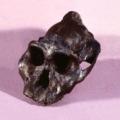Our bodies are records of our evolution. Look at an unfolding embryo, a genome, or a skeleton and you will see our inner fishes, our inner mammals, our inner apes. We carry within us physical evidence of the developmental processes and biological traits that humans share with all — yes, all — other organisms. Accordingly, we don't need ancient fossils or artifacts to know that evolution occurs, but without them we would understand far less about all that came before us. Without fossils we would have no way of knowing about speciation and extinction events from the past. We could not have learned about the existence of strange and fascinating creatures like Neanderthals. Although a fossil is only a snapshot of a moment in evolutionary history, if you find enough of them, and if you can link them up through their anatomy, and if you can date them reliably with geological and geochemical methods, you can construct a family tree that explains how organisms that once lived on Earth contributed to the life that inhabits it today.
Paleoanthropologists do this sort of work-reconstructing family trees and resurrecting extinct creatures-with human and other primate fossils. They are part of the larger discipline of evolutionary biology and although they are paleontologists, they tend to be called paleoanthropologists because for much of the evolutionary history of humans, cultural evolution was occurring in step with biological evolution. Using the physical remains of our past, paleoanthropologists try to answer questions like the following:
When, where and how did human ancestors diverge from those of chimpanzees, gorillas, orangutans? How did early hominins (human ancestors) evolve to walk on only two legs? How did our large brains evolve? How did becoming bipedal and then big-brained, change hominin life? What did hominins eat and how did their diets change over time? How did big brains and sophisticated tool-making co-evolve through time? Which species are our direct ancestors and which are our evolutionary cousins? How many hominin species comprise our evolutionary tree? Did any hominin species co-exist in space and time? When did qualities that we consider to be 'human' first emerge and did they emerge all at once or bit by bit? How and when did humans colonize every continent on the planet? What were the small- and large-scale environmental conditions during hominin evolutionary history and how did these conditions influence the evolutionary changes that our ancestors experienced?
Each new fossil discovery has the potential to change our understanding of human evolution. As you will see in these articles, however, there is a strong framework already in place, thanks to the record of evidence that fieldworkers have amassed and to the research that scientists have accomplished.














